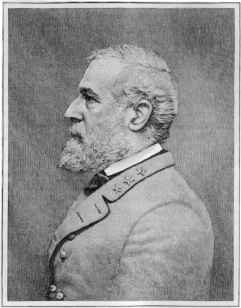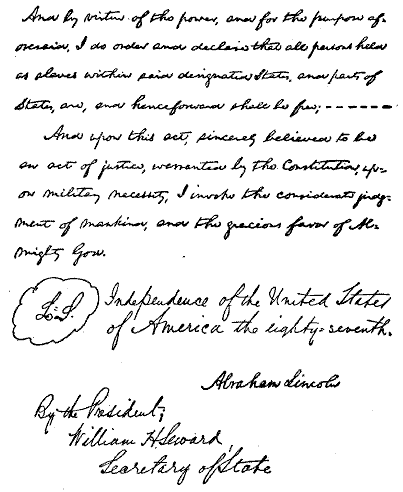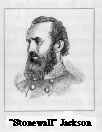Resource Center OLLibrary
|
298 |
|
[1862 |
"Stonewall" Jackson (§ 326) had started to drive General
Banks' Union army out of the Shenandoah valley,1 in
West Virginia, and make the authorities in Washington think that
the capital was in danger of immediate attack. With his 17,000 men
Jackson made Banks' 9000 beat a hasty retreat to the Potomac; and
he effectually prevented McClellan from getting any help from the
40,000 Union troops at Fredericksburg. Then Lee sent General
Stuart with a dashing body of cavalry to see what mischief he
could do. Stuart rode clear round McClellan's army, tore up the
railways, burned car loads of provisions, and made matters very
uncomfortable for the Union general.
From June 25 to July 1 (1862), Lee and McClellan
were engaged in a number of desperate fights around Richmond,
known as the "Seven Days' Battles";2 Lee captured many
guns and prisoners; the Union forces retreated to the James River,
and the government at Washington recalled McClellan and his army
to the neighborhood of the national capital. In these last battles
over 15,000 men had been lost on each side. The Union army had
accomplished nothing decisive, though it had been within sight of
the spires of the Confederate capital, and of the wooden or
"Quaker guns" which helped to guard it.3 Once the alarm
there was so great that a niece of Jefferson Davis wrote to a
friend, "Uncle Jeff thinks we had better go to a safer place than
Richmond." On the other hand, President Lincoln called for
additional volunteers; and new forces, shouting, "We are coming,
Father Abraham, three hundred thousand more," began to go forward
to the aid of the government.
338. The Second Battle of Bull Run; Lee's
Advance across the Potomac; Battle of Antietam. Near the last
of August (1862),
1 General Joseph E.
Johnston had been in command since the battle of Bull Run, July,
1861. He was wounded at the battle of Seven Pines, May 31, 1862,
and Lee then took command.
2 In the last of these battles, that
at Malvern Hill, Lee's forces were driven back with heavy loss.
During the Peninsular campaign the armies of Frémont,
Banks, and McDowell were united under the name of the Army of
Virginia, and the command of this force was given to General Pope,
who had been successful in the West.
3 One of the humorous features of the
war was the use of wooden cannon by the Confederates in their
fortifications at Manassas, Richmond, and elsewhere. It was some
time before the Union army found out this clever trick of the
"Quaker guns," which, as a "contraband" said, were "just as good
to scare with as any others."

GENERAL LEE
|
300 |
|
[1862 |
Lee advanced his forces against General Pope, who had been
given command of the Army of Virginia, and met him in the second
battle of Bull Run. "Stonewall" Jackson did the heaviest of the
fighting. Pope was defeated, but fell back in good order to
Washington and resigned his command.
Not long after, Lee
crossed the Potomac above Washington, his men singing exultingly,
"Maryland, my Maryland." Lee believed that thousands of the
Maryland people would welcome him as their deliverer, and would
join him in a march against Philadelphia. In this he was sorely
mistaken. In the middle of September "Stonewall" Jackson captured
Harpers Ferry, and thus obtained a quantity of arms and some
provisions. McClellan now advanced to meet Lee. At Antietam Creek
(or Sharpsburg) (Map, p. 288) one of the bloodiest battles of the
war was fought (September 17, 1862); and the bodies of the "boys
in blue" and of the "boys in gray" lay in ranks like swaths of
grass cut by the scythe.1 After the terrible contest
Lee retreated across the Potomac. McClellan followed, but he moved
so slowly that the government took the command of the army from
him and gave it to General Burnside.
339. Battles of
Fredericksburg and Murfreesboro. General Burnside set out to
march on Richmond, but found the Confederates strongly
fortified2 on the hills around Fredericksburg, on the
Rappahannock. (Map, p.288.) In the battle which ensued (December
13, 1862) he was defeated and forced to fall back toward
Washington. General Hooker, or "Fighting Joe Hooker" as his men
called him, then took command of Burnside's army.
This was the last battle
of the year in the East. In the West the Union forces had gained a
victory at Pea Ridge, Arkansas, and had taken Corinth,
Mississippi; the Confederates attempted to retake it, but were
driven back with frightful loss. Bragg invaded Kentucky; Buell
fought him at Perryville, and Bragg fled
1
Union forces actually engaged at Antietam were estimated at
about 60,000 McClellan's available strength was probably
double that of Lee's. Confederate forces, 40,000. See "The Century
Company's War Book," II, 603. Loss nearly 12,000 on each side.
Authorities differ about the strength of the two armies. "Loss" in
all cases is understood to include wounded as well as
killed.
2
Burnside had about 116,000 men; Lee had nearly 80,000
strongly entrenched on and near the hills. Burnside lost 12,000
men, and Lee not quite half that number.
|
1863] |
|
301 |
with his plunder and took shelter behind the Cumberland
Mountains. Grant and Sherman then moved against Vicksburg, but the
Confederate cavalry cut off Grant's supplies and Sherman was
repulsed. Next, General Rosecrans moved against Bragg. He met the
Confederate general at Murfreesboro, Tennessee (December 31,
1862). (Map, p. 292.) Each had about 40,000 men. The contest raged
for three days. Rosecrans said, "The battle must be won." The
Union forces held their ground,1 and Bragg retreated in
the night.
340. President
Lincoln's Proclamation of Emancipation, 1863; its Results; the
Thirteenth Amendment to the Constitution. President Lincoln
had entered office resolved, as he then said, not to interfere
with slavery (§ 319). But the progress of the contest
convinced him that slavery was the real cause and the main
strength of the war against the Union. He saw that he must strike
slavery a decided blow.
On New Year's Day, 1863,
the President issued a proclamation, freeing all the black men in
those states of the South which were still at war against the
Union. Thus by a single stroke of the pen the government gave over
three millions of human beings that most precious yet most
perilous of all rights -- the ownership of themselves.
No greater event is
recorded in the pages of American history. After the expiration of
nearly a hundred years the nation at last included the negro in
that Declaration of Independence, which declares that "all men are
created equal," -- that is, with equal natural rights to "life,
liberty, and the pursuit of happiness."
Many thousands of these
"freedmen" enlisted in the Union army; but the greater part
remained quietly at work on the Southern plantations. The freedom
of the whole body of slaves in the country was not secured until
after the close of the war. Then the Thirteenth Amendment to the
Constitution (1865) declared that slavery should no longer exist
in the United States.2 From an industrial point of
view, that final act of emancipation has
1 Union loss, 14,000;
Confederate, 11,000.
2 See the Constitution Amendments,
Article XIII.
|
302 |
|
[1863 |
|
proved to be as much an advantage to the white. race
as to the negroes themselves. Free labor has brought a
greater degree of prosperity than slave labor ever did.
Now that the South is no longer hampered by having to
hold the negroes in bondage, it has found its real
strength and its true and lasting prosperity.
|
REDUCED COPY OF A PART OF THE EMANCIPATION PROCLAMATION1
January 1, 1863

1 President
Lincoln issued a preliminary proclamation of emancipation on
September 22, 1862, giving one hundred days warning to the South.
In case any state chose to return to the Union within that time
its slaves were not to be set at liberty by the final
proclamation.
The
President said: "My paramount object in this struggle is to save
the Union, and is not either to save or to destroy slavery. If I
could save the Union without freeing any slave, I would do it; and
if I could save it by freeing all the slaves, I would do it; and
if I could save it by freeing some and leaving others alone, I
would also do that." -- Letter to Horace Greeley, August 22,
1862.
 342.
The War in the East; Battle of Chancellorsville. In
the spring (1863) General Hooker crossed the Rapidan,
intending to advance on Richmond. But he had no sooner
started than General Lee, with "Stonewall" Jackson
(§ 326), met him at Chancellorsville.1
(Map, p. 288.) Here a two days' battle was fought (May
2-3, 1863). At a critical moment General Hooker was
stunned by a cannon ball and lay senseless for many
hours. During all that time his army was "without a
head."
342.
The War in the East; Battle of Chancellorsville. In
the spring (1863) General Hooker crossed the Rapidan,
intending to advance on Richmond. But he had no sooner
started than General Lee, with "Stonewall" Jackson
(§ 326), met him at Chancellorsville.1
(Map, p. 288.) Here a two days' battle was fought (May
2-3, 1863). At a critical moment General Hooker was
stunned by a cannon ball and lay senseless for many
hours. During all that time his army was "without a
head."


